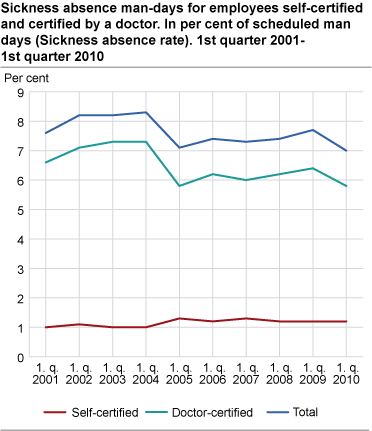Content
Published:
This is an archived release.
Considerable drop in doctor-certified sickness absence
Sickness absence fell from 7.7 to 7 per cent from the first quarter of 2009 to the first quarter of 2010; a decrease of 8.9 per cent.
Doctor-certified sickness absence fell from 6.4 to 5.8 per cent; a decrease of 9.7 per cent. Self-certified sickness absence dropped by 4.7 per cent, but rounding off to one decimal led to the same level as last year; 1.2 per cent.
Sickness absence for men decreased from 6.2 to 5.6 per cent. For women it fell from 9.5 to 8.7 per cent. This equals a percentual drop of 9.7 and 8.3 per cent respectively.
Sickness absence in the first quarter of 2010 was 7.9 per cent lower than in the first quarter of 2001, the year of implementation of the agreement on an inclusive labour market.
Less seasonal flu
This seems to be the main cause for the drop in the sickness absence. Last winter the seasonal flu hit us in the first quarter. This time the swine flu arrived in the third and fourth quarters of 2009. The reduction can be partly explained by a slight increase in the use of graded rather than full-time sickness benefits 1.
Reduced sickness absence in all industries
All industries showed a reduction in sickness absence from the first quarter of 2009 to the first quarter of 2010. <p > <p > Amongst the major industries, the decline was greatest in the information and communication industry and in the construction industry, by 13.6 and 12.5 per cent respectively. Accommodation and food service activities had the smallest decline, by 2.6 per cent.
Central government had the strongest decrease
Sickness absence in central government (including health enterprises) had the strongest reduction by 10.2 per cent. Local government and private sector had a decrease of 9.2 and 8.8 per cent respectively. It is the doctor-certified sickness absence that contributes to the reduction within all of the sectors.
The sickness absence level was lowest in central government, with 6.5 per cent, and highest in local government, with 8.6 per cent.
Strongest decrease amongst the youngest
Sickness absence fell within all age groups. The group below 25 years had the clearest fall of 14.5 per cent. The 40-44 year olds had the smallest drop, of 8.3 per cent. Sickness absence for men fell by 10.4 per cent and for women it dropped by 9.3 per cent.
These results are based on data on sickness absence certified by a doctor, as the survey on self-certified absence does not contain data on sickness absence by age.
Technical informationRates of change The sickness absence rates are presented using one decimal point. More decimal points are used when calculating the rates of change in order to get more accurate figures. These will therefore differ somewhat from the rates of change produced when using the published rounded figures. The statistics do not cover self - employed persons . |
| 1 Sentence was altered 22 June 2010 at 11.00 |
Tables
- Table 1 Sickness absence man-days for employees self-certified and certified by a doctor. In per cent of scheduled man-days (Sickness absence rate). Quarterly figures. 2000-2010
- Table 2 Sickness absence man-days for employees self-certified and certified by a doctor, by sex. In per cent of scheduled man-days (Sickness absence rate). Quarterly figures. 2000-2010
- Table 28 Sickness absence, by type of absence(self-certified or doctor-certified) and duration within the quarter
- Table 34 Cases of sickness absence and sickness absence man-days, self-certified and doctor-certified absence, by sex and duration. Per cent. Quarterly figures. 2009-2010
Contact
-
Arbeidsmarked og lønn
E-mail: arbeidsmarked@ssb.no
-
Unn H. Høydahl
E-mail: unnh.hoydahl@ssb.no
tel.: (+47) 40 90 23 77

